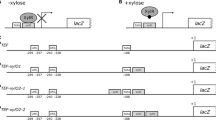Summary
The Staphylococcus xylosus xyl genes were cloned in Staphylococcus carnosus by complementation to xylose utilization. Xylose isomerase assays under inducing (xylose present) and non-inducing (xylose absent) conditions indicated the presence of a regulated xylA gene on the recombinant plasmid. The nucleotide sequence (4520 bases) revealed three open reading frames with the same polarity. They were identified by sequence homologies as xylR, encoding the Xyl repressor, xylA, encoding xylose isomerase and xylB, encoding xylulokinase. Primer extension analyses indicated constitutive transcription of xylR and xylose-inducible transcription of xylA. Promoter consensus sequences were found upstream of both transcriptional start sites. A transcriptional terminator between xylR and xylA separates the different transcriptional units. Potential regulatory elements were identified by sequence analysis and suggest a repressor-operator mechanism for the regulation of xylAB expression.
Similar content being viewed by others
References
Bergmeyer HV (1974) Methoden der enzymatischen Analyse. 3rd ed. Verlag Chemie, Weinheim, pp 1416–1420
Boylan SA, Chun KT, Edson BA, Price CW (1988) Early-blocked sporulation mutations alter expression of enzymes under carbon control in Bacillus subtilis. Mol Gen Genet 212:271–280
Devereux J, Haeberli P, Smithies O (1984) A comprehensive set of sequence analysis programs for the VAX. Nucleic Acids Res 13:387–395
Fujita Y, Fujita T, Miwa Y, Nihashi J, Aranati Y (1986) Organization and transcription of the gluconate operon, gnt, of Bacillus subtilis. J Biol Chem 261:13744–13753
Gärtner D, Geißendörfer M, Hillen W (1988) Expression of the Bacillus subtilis xyl-operon is repressed at the level of transcription and is induced by xylose. J Bacteriol 170:3102–3109
Götz F, Kreutz B, Schleifer KH (1983a) Protoplast transformation of Staphylococcus carnosus by plasmid DNA. Mol Gen Genet 189:340–342
Götz F, Zabielski J, Philipson L, Lindberg M (1983b) DNA homology between the arsenate resistance plasmid pSX267 from Staphylococcus xylosus and the penicillinase plasmid p1258 from Staphylococcus aureus. Plasmid 9:126–137
Götz F, Schuhmacher B (1987) Improvements of protoplast transformation in Staphylococcus carnosus. FEMS Microbiol Lett 40:258–288
Hastrup S (1988) Analysis of the Bacillus subtilis xylose regulon. In: Ganesand AT, Horch J (eds) Genetics and biotechnology of bacilli, vol 2. Academic Press, San Diego, pp 79–84
Hawley DK, McClure WR. (1983) Compilation and analysis of Escherichia coli promoters. Nucleic Acids Res 11:2237–2255
Hillen W, Klein RD, Wells RD (1981) Preparation of milligram amounts of 21 deoxyribonucleic acid restriction fragments. Biochemistry 20:3748–3756
Jeffries TW (1983) Utilization of xylose by bacteria, yeasts and fungi. Adv Biochem Eng 17:1–32
Kloos WE (1980) Natural populations of the genus Staphylococcus. Annu Rev Microbiol 34:559–592
Kreutz B, Götz F (1984) Construction of Staphylococcus plasmid vector pCA43 conferring resistance to chloramphenicol, arsenate, arsenite and antimony. Gene 31:301–304
Kreuzer P, Gärtner D, Allmannsbeger R, Hillen W (1989) Identification and sequence analysis of the Bacillus subtilis W23 encoded xylR gene and xyl operator. J Bacteriol 171:3840–3845
Maniatis T, Fritsch E, Sambrook J (1982) Molecular cloning. A laboratory manual. Cold Spring Harbor Laboratory. Cold Spring Harbor, NY
Nerf P (1987) Klonierung und Sequenzierung der 16S rDNA von Staphylococcus carnosus. Diplomarbeit, Technische Universität München
Pettigrew DW, Ma D, Donrad CA, Johnson JR (1988) Escherichia coli glycerol kinase. J Biol Chem 263:135–139
Sanger F, Nicklen S, Coulson AR (1977) DNA sequencing with chain terminating inhibitors. Proc Natl Acad Sci USA 74:5463–5467
Schellenberg GD, Sarthy A, Larson AE, Backer MP, Crabb JW, Lindstrom M, Hall BD, Furlong CE (1984) Xylose isomerase from Escherichia coli. J Biol Chem 259:6826–6832
Shine J, Dalgarno L (1974) The 3′-terminal sequence of Escherichia coli 16S ribosomal RNA: complementary to nonsense triplets and ribosomal binding sites. Proc Natl Acad Sci USA 71:1342–1346
Southern EM (1975) Detection of specific sequences among DNA fragments separated by gel electrophoresis. J Mol Biol 98:503–517
Sullivan MA, Yasbin RE, Young FE (1984) New shuttle vectors for Bacillus subtilis and Escherichia coli which allow rapid detection of inserted fragments. Gene 29:21–26
Wilhelm M, Hollenberg CP (1985) Nucleotide sequence of the Bacillus subtilis xylose isomerase gene: extensive homology between the Bacillus and Escherichia coli enzyme. Nucleic Acids Res 13:5717–5722
Wilkie KCB (1979) The hemicelluloses of grasses and cereals. Adv Carbohydr Chem Biochem 36:15–264
Williams JG, Mason PJ (1985) Hybridisation in the analysis of RNA. In: Hames BD, Higgins SJ (eds) Nucleic acids hybridisation — A practical approach. IRL Press, Oxford, UK, pp 139–160
Yanisch-Perron C, Vieira J, Messing J (1985) Improved M13 phage cloning vectors and host strains: nucleotide sequence of the M13mpl8 and pUC19 vectors. Gene 33:103–119
Author information
Authors and Affiliations
Additional information
Communicated by W. Goebel
Rights and permissions
About this article
Cite this article
Sizemore, C., Buchner, E., Rygus, T. et al. Organization, promoter analysis and transcriptional regulation of the Staphylococcus xylosus xylose utilization operon. Molec. Gen. Genet. 227, 377–384 (1991). https://doi.org/10.1007/BF00273926
Received:
Issue Date:
DOI: https://doi.org/10.1007/BF00273926




